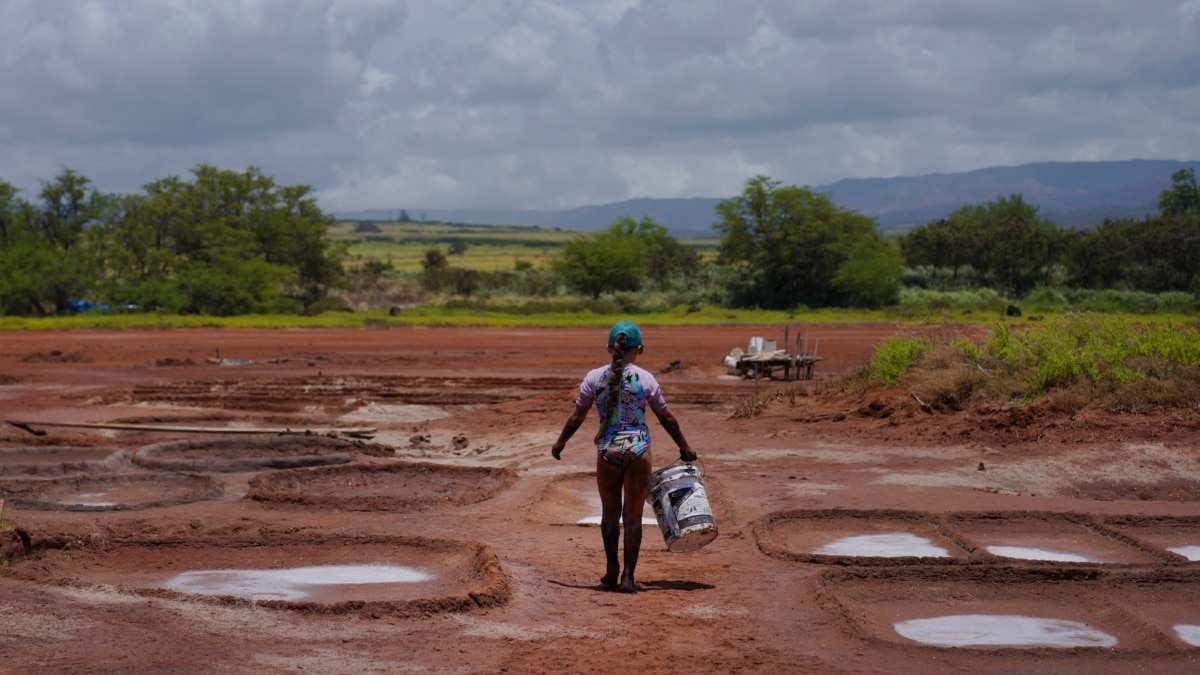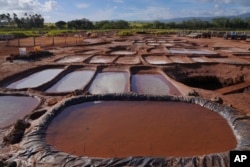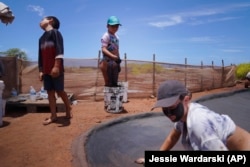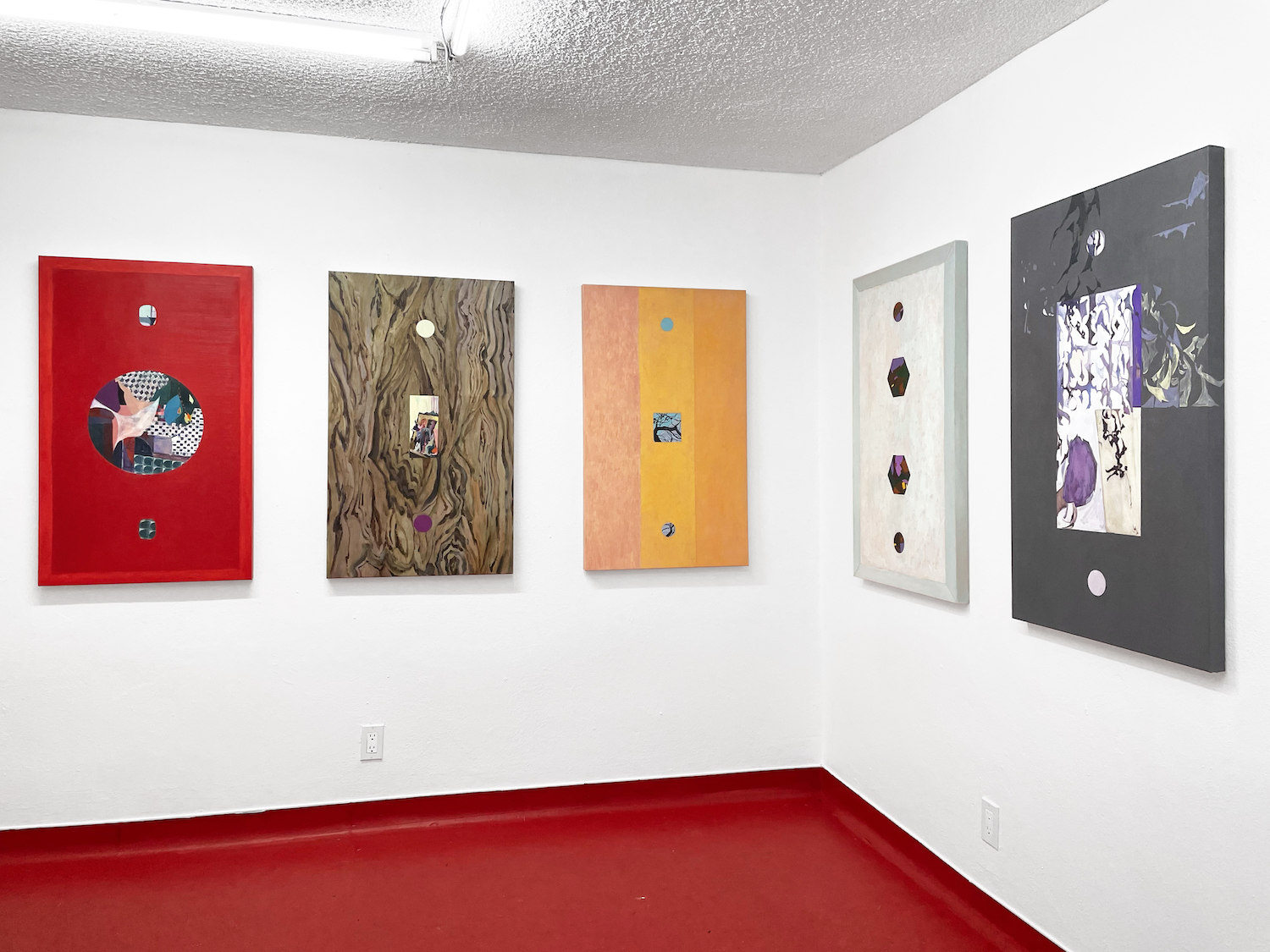Hawaii
Hawaiian Salt Makers Aim to Protect Tradition

Last summer on the Hawaiian Island of Kauai, Tina Taniguchi was working close to the ground. Her coconut leaf hat covered most of her thick brown hair. Wet soil had gotten on her clothes and her smiling face.
Taniguchi smiles a lot while working on the Hanapepe salt patch on the west side of Kauai. It is a piece of land about half a hectare in size with pools of salty water. The salt becomes crystals as the water dries.
“It’s hard work, but for me it’s also play,” Taniguchi said with a laugh.
Spiritual tradition
Taniguchi’s family is one of 22 families who make “paakai,” the Hawaiian word for salt, following a cultural and spiritual tradition. Hanapepe is one of the last remaining salt patches in Hawaii. Its holy salt can be traded or given away but must never be sold. Hawaiians use it in cooking, healing, rituals and as protection.
Taniguchi drives a car for about an hour to get to the salt patch. For her, it is like religion and play at the same time. It is the time when she makes a spiritual connection to the land.
“This would be a religious practice of mine for sure,” Taniguchi said. “My dad raised us saying that these mountains are his church, and the ocean is where you get cleansed.”
Malia Nobrega-Olivera is another salt maker. She is also an educator and activist who leads efforts to preserve this old tradition. Her grandfather helped form the group of salt-making families called Hui Hana Paakai. The organization’s goal, she said, is to communicate with the landowner, the state of Hawaii, whenever problems arise. Nobrega-Olivera said the salt patch is part of the lands taken away from Native Hawaiians after the U.S.-supported overthrow of Hawaii’s monarchy in 1893.
Native claims to the land
“Regardless of what a piece of paper might say, we are stewards of the area,” she said.
Over the past 10 years there have been several threats to this field. They include development, pollution from a neighboring airfield, damage to the sand from vehicle traffic and waste left by visitors to the nearby beach. In addition, rising sea levels and weather might stop the practice.
Nobrega-Olivera believes Western science and native knowledge can combine to combat the effects of climate change and save the salt patch. The steps she takes include building up the wells’ edges, so water won’t cover the salt beds. Another step is to prevent damage to the beach from vehicle traffic.
“Some ask us why we can’t move this practice to a different location,” she said. “That’s impossible because our cultural practice is particular to this land. There are elements here that make this place special for making this type of salt. You cannot find that anywhere else.”
The process of making salt
The process of turning sea water into salt can be slow. The season begins once the rain stops, and water starts to disappear from the salt beds. Ocean water travels underground and enters the wells. Each family has their own well. As water enters the well, so do tiny, red brine shrimp. These small ocean animals give Hanapepe salt its unusual, sweet taste, said Nobrega-Olivera.
The families first clean the salt beds and line them with black clay. Then they move water from the wells into the beds. There, salt crystals form. The top level, or layer, is the whitest. It is used for table salt. The middle layer is pinkish and is used in cooking, while the bottom layer, which is a deep red color, is used in blessings and rituals.
Fires on the island of Maui in August claimed 100 lives. After the fires, salt makers began sending their salt to survivors, so they can “make their food delicious and bring some of that joy into their lives,” Nobrega-Olivera said.
Keeping traditions alive
Interest in Hawaiian culture and language has recently grown on the islands, Nobrega-Olivera said. She now thinks about how to teach her knowledge to younger generations.
One way she honors the Hanapepe salt patch is by writing Hawaiian songs and chants. She recently taught some school children one of those chants using the words aloha aina, which means “love of the land.”
“Aloha aina captures our philosophy, the reason we do this,” Nobrega-Olivera said. “You take care of the land, and the land takes care of you.”
I’m Dan Friedell.
And I’m Jill Robbins.
Deepa Bharath reported on this story for the Associated Press. Jill Robbins adapted it for Learning English.
______________________________________________
Words in This Story
patch – n. a small area of land where a particular plant or crop grows or is produced
crystal – n. a small piece of a substance that has formed naturally into a regular symmetrical shape.
ritual – n. a religious service or other ceremony which involves a series of actions performed in a fixed order
cleanse – v. to make clean, pure
steward – n. someone who has the responsibility for looking after property
preserve – v. to save or protect something from damage or decay
clay – n. a kind of earth that is soft when it is wet and hard when it is dry
blessing – n. a prayer asking God to look kindly upon the people who are present or the event that is taking place
chant –n. to sing a word or phrase repeatedly usually in connection with prayers or a religious ceremony
philosophy –n. a system of ideas about truth and meaning
What do you think of this story? Write to us in the Comments Section.

Hawaii
Federal jury returns not guilty verdicts in sprawling bribery case against ex-city prosecutor

HONOLULU (HawaiiNewsNow) – After nearly two days of deliberation, a federal jury returned a not guilty verdict Friday in the sprawling bribery case against Keith Kaneshiro, Honolulu’s longest-serving prosecutor.
The decision comes nearly two years after Kaneshiro and five others were indicted on conspiracy to commit honest services fraud, bribery and conspiracy against rights. Verdicts were also handed down for the others in the case — all campaign donors affiliated with a high-profile Honolulu engineering firm.
Firm owner Dennis Mitsunaga, who was jailed during trial following new allegations of witness tampering, was also found not guilty.
The jury also delivered not guilty verdicts for the others in the case: Executive Aaron Fujii, executive Chad McDonald, firm Executive Director Terri Ann Otani, and firm attorney Sheri Tanaka.
After the verdict was read, Kaneshiro spoke to reporters, reacting to the decision and expressing his frustration over how the media handled the case.
“I feel vindicated,” he said. “But how am I going to get back my reputation? Because all the information that’s been going out how been negative about me.”
Attorney Sheri Tanaka also spoke, getting emotional about how everything played out.
“This was completely wrong what happened,” she said. “And I think … what the government did for each one of our families, what they put us through, the horrific things they did, of pitting family members against friends, and every step of the way, it was awful. And we’re so very grateful that justice was served today.”
Jurors started their deliberations in the case on Wednesday, after closing arguments wrapped up on the 26th working trial day. In their final pitch to the jury, defense attorneys argued the government hadn’t shown evidence of bribery but had twisted Hawaii traditions of giving and omiyage into something sinister.
The government’s case revolved around campaign donations.
Mitsunaga and his employees, federal prosecutors argued, funneled nearly $50,000 to Kaneshiro’s coffers in exchange for his office going after an enemy of the firm — Laurel Mau, a fired employee who had sued for discrimination.
Mau was an architect at the firm and she’d been accused of stealing by taking side jobs. During trial, Mau said she was directed to take on some of those jobs by firm employees. Meanwhile, some of the jobs were offered pro bono.
PREVIOUS COVERAGE:
A state judge ultimately threw out the criminal charges against her.
And during the bribery trial, a key witness for the government — retired HPD Officer Rudy Alivado — admitted he lied under oath in multiple court proceedings in order to protect his longtime friend, Mitsunaga, who he’d gone to school with.
One of those cases was Mau’s civil discrimination trial, which she lost.
The Kaneshiro trial was another stunning chapter in a years-long federal corruption probe that previously ended with guilty verdicts against ex-Police Chief Louis Kealoha and his wife, Katherine, who was a high-ranking city prosecutor, along with several police officers. The Kealohas remain behind bars.
Separately, the government is pursuing a case against three former high-ranking city officers in connection with a $250,000 payout to Louis Kealoha in 2017.
The Kaneshiro trial also had no shortage of twists and turns.
In addition to Mitsunaga being jailed during the proceedings, the judge in the case — U.S. District Court Judge J. Michael Seabright — recused himself after being identified as a victim or witness in a murder-for-hire case linked to the trial.
A new judge was selected to preside over trial.
This story will be updated.
Copyright 2024 Hawaii News Now. All rights reserved.
Hawaii
Motorcyclist dead after ramming into rock embankment on Hawaii Island

HONOLULU (HawaiiNewsNow) – A 59-year-old man is dead after ramming his motorcyclist into a rock embankment on Hawaii Island Thursday evening.
Police responded to the scene around 5:40 p.m. at the intersection of Mamaloha Highway and Leilani Street.
Officials said the motorcyclist overtook several vehicles near the Manuka State Park entrance, before striking a rock embankment and flying off his motorcycle.
He was taken to the hospital where he was later pronounced dead.
The motorcyclist remains unidentified at this time, pending positive identification and notification of next of kin.
It’s part of a deadly trend on Hawaii Island roads.
This is now the 18th traffic fatality this year compared to just 8 at this time last year.
Copyright 2024 Hawaii News Now. All rights reserved.
Hawaii
Dramatic weekend at youth soccer camps – West Hawaii Today
-

 Politics1 week ago
Politics1 week agoRFK Jr said a worm ate part of his brain and died in his head
-

 World1 week ago
World1 week agoPentagon chief confirms US pause on weapons shipment to Israel
-

 World1 week ago
World1 week agoConvicted MEP's expense claims must be published: EU court
-

 News1 week ago
News1 week agoStudents and civil rights groups blast police response to campus protests
-

 Politics1 week ago
Politics1 week agoCalifornia Gov Gavin Newsom roasted over video promoting state's ‘record’ tourism: ‘Smoke and mirrors’
-

 Politics1 week ago
Politics1 week agoOhio AG defends letter warning 'woke' masked anti-Israel protesters they face prison time: 'We have a society'
-

 News1 week ago
News1 week agoNine Things We Learned From TikTok’s Lawsuit Against The US Government
-

 Politics1 week ago
Politics1 week agoBiden’s decision to pull Israel weapons shipment kept quiet until after Holocaust remembrance address: report
























